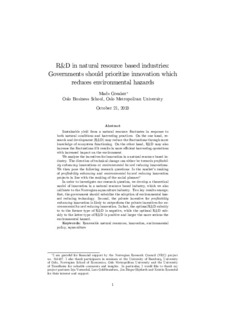| dc.description.abstract | Sustainable yield from a natural resource áuctuates in response to both natural conditions and harvesting practices. On the one hand, research and development (R&D) may reduce the áuctuations through more knowledge of ecosystem functioning. On the other hand, R&D may also increase the áuctuations if it results in more e¢ cient harvesting operations with increased impact on the environment. We analyze the incentives for innovation in a natural resource based industry. The direction of technical change can either be towards proÖtability enhancing innovations or environmental hazard reducing innovations. We then pose the following research questions: Is the marketís ranking of proÖtability enhancing and environmental hazard reducing innovation projects in line with the ranking of the social planner? In order to investigate our research question, we develop a theoretical model of innovation in a natural resource based industry, which we also calibrate to the Norwegian aquaculture industry. Two key results emerge; Örst, the government should subsidize the adoption of environmental hazard reducing technology. Second, the private incentive for proÖtability enhancing innovation is likely to outperform the private incentives for environmental hazard reducing innovation. In fact, the optimal R&D subsidy to to the former type of R&D is negative, while the optimal R&D subsidy to the latter type of R&D is positive and larger the more serious the environmental hazard. | |
